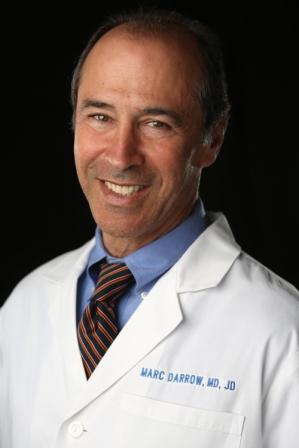
Marc Darrow MD,JD
I have already written about stem cell therapy as an alternative to meniscus surgery and Platelet Rich Plasma therapy as a meniscus tear alternative. In this article I want to offer research surrounding whether or not you even have a meniscus tear despite what your MRI may or may not say.
Do you even have a meniscus tear? “Understanding that this MRI finding does not represent a true meniscus tear may save patients from unnecessary arthroscopic surgery.”
The accuracy of MRIs, specifically the accuracy of MRIs in sending people to a knee surgery has always been questioned. A February 2021 study says (1) “MRI could be a diagnostic tool for meniscus tears, but has limited accuracy in their classification of the type and location.” Simply, it is not without its errors. Of course in this case you may get a surgery you did not need.
Also in February 2021, this editorial from Peter R Kurzweil, MD, Orthopedic surgeon, published in the journal Arthroscopy (2)
“The false-positive finding of anterior horn meniscus (pseudo) tear on magnetic resonance imaging (MRI) is an important finding of which to be aware. We have recently seen awareness similarly raised regarding root tears of the meniscus, which, if overlooked, could have detrimental consequences. Manifestations of the MRI finding of meniscus pseudotear arise from the variability of the insertion of the transverse geniculate ligament into the anterior horn of the lateral meniscus. Bearing in mind that anterior knee pain is a common reason that patients present for an orthopaedic and sports medicine evaluation, the understanding that this MRI finding does not represent a true meniscus tear may save patients from unnecessary arthroscopic surgery.”
“The negative role of MRI in promoting surgical expectations needs further consideration” – “A lack of evidence for the use of arthroscopy”
Also from February 2021, this paper in the journal Musculoskeletal science & practice (3). This is what a group of physical therapists wrote:
“Current clinical practice guidelines for degenerative meniscal tears recommend conservative management yet patients are frequently referred to the consultant orthopaedic surgeon despite a lack of evidence for the use of arthroscopy.”
What this study was about was that people went to their doctor fully expecting a meniscus surgery recommendation. The doctor told them that they may be better off with physical therapy. This seemed top upset some of the patients who conveyed their thoughts to the physical therapists in this way:
“Participants described beliefs, strongly influenced by magnetic resonance imaging (MRI) results, that damaged structures were causing their knee problems (“The meniscus is busted”), and expected their knee problems to inevitably worsen over time (“It’s only going to get worse”). Participants were hopeful the orthopaedic consultation would clarify their problem and lead to a subsequent definitive intervention (“Hopefully they will give me answers”). Most participants viewed surgery as “the quick and straightforward solution” necessary to repair faulty cartilage. Exercise was not seen as compatible with the recovery process by most (“Would I make it worse?”).
This is how the physical therapists concluded their paper: “How participants understand their knee problem contributes to surgical expectations and perceptions that it is not amenable to conservative management. Findings suggest a need to educate both patients and primary care clinicians about the safety and efficacy of exercise as first-line therapy for degenerative meniscal tears. The negative role of MRI in promoting surgical expectations needs further consideration.”
“There is a noticeable increase in the unnecessary ordering of Magnetic Resonance Imaging (MRI) of the knee in older patients.”
This is a study from November 2020. (4) “There is a noticeable increase in the unnecessary ordering of Magnetic Resonance Imaging (MRI) of the knee in older patients. This quality improvement study assessed the frequency of unnecessary pre-consultation knee MRIs and investigated the effect on the outcome of the patients’ consultation with the orthopedic surgeon.”
650 medical charts of patients aged 55 years or older referred to an orthopedic clinic with knee complaints were reviewed. Of the 650 patient charts reviewed, 225 patients presented with a pre-consultation MRI, 76% of which were not useful for the orthopedic surgeon.
The ordered knee MRI scans were considered not useful because they were requested for confirmed meniscal tear for patients more than 55 years, suspected degenerative disorder and ligament/tendon injury, or for patients with severe osteoarthritis without locking or extension. These MRI scans were done despite the absence of signs of effusion, tenderness, soft tissue swelling, decreased range of motion, or difficulty of weight-bearing, a lack of persistent knee joint pain at the time of assessment, or with no x-ray before ordering MRI.”
It was later noted: “patients with pre-consult (before being sent to the surgeon) MRI were less likely to be considered for total knee arthroplasty (TKA).”
Do you need an MRI before I come in?
In many emails that I get, people ask me if they should get an MRI. Usually an MRI is not necessary as outlined in the research above. I want to first do a physical examination. Other people email and some of them have had a recent MRI and a report of what the MRI recorded and what the radiologist interpreted. Some of these MRI reports are deep and comprehensive in their description of an unseemly insurmountable amount of damage to the person’s knees. The person who sends in the email will sometimes add something in the email to suggest that their MRI is one of the worst that their doctor has ever seen. The funny thing is when we ask, “well how does your knee feel today?” Sometimes we get the answer, “not bad.”
Meniscus tear treatment at the Darrow Stem Cell Institute
The meniscus has an ability to heal itself. When someone comes into our office with knee problems we start with a conversation so we can learn about the patient’s lifestyle and what are his/her goals of the treatment. Is it to get back to marathon training or is it to get up and down a staircase without his/her knee locking up? Then we will do a detailed physical examination looking for those signs that will tell us how helpful stem cell therapy may be.
Please see my articles
Do you have questions? Ask Dr. Darrow

A leading provider of stem cell therapy, platelet rich plasma and prolotherapy
11645 WILSHIRE BOULEVARD SUITE 120, LOS ANGELES, CA 90025
PHONE: (800) 300-9300 or 310-231-7000
Stem cell and PRP injections for musculoskeletal conditions are not FDA approved. We do not treat disease. We do not offer IV treatments. There are no guarantees that this treatment will help you. Prior to our treatment, seek advice from your medical physician. Neither Dr. Darrow, nor any associate, offer medical advice from this transmission. This information is offered for educational purposes only. The transmission of this information does not create a physician-patient relationship between you and Dr. Darrow or any associate. We do not guarantee the accuracy, completeness, usefulness or adequacy of any resource, information, product, or process available from this transmission. We cannot be responsible for the receipt of your email since spam filters and servers often block their receipt. If you have a medical issue, please call our office. If you have a medical emergency, please call 911.
References
1 Kim SH, Lee HJ, Jang YH, Chun KJ, Park YB. Diagnostic Accuracy of Magnetic Resonance Imaging in the Detection of Type and Location of Meniscus Tears: Comparison with Arthroscopic Findings. Journal of Clinical Medicine. 2021 Jan;10(4):606.
2 Kurzweil PR. Editorial Commentary: False-Positive Meniscus Pseudotear on Magnetic Resonance Imaging: A False Sign That Rings True.
3 O’Leary H, Ryan LG, Robinson K, Conroy EJ, McCreesh K. “You’d be better off to do the keyhole and make a good job of it” a qualitative study of the beliefs and treatment expectations of patients attending secondary care with degenerative meniscal tears. Musculoskeletal Science and Practice. 2021 Feb 1;51:102281.
4 Mohammed HT, Yoon S, Hupel T, Payson LA. Unnecessary ordering of magnetic resonance imaging of the knee: A retrospective chart review of referrals to orthopedic surgeons. Plos one. 2020 Nov 2;15(11):e0241645. —1315


